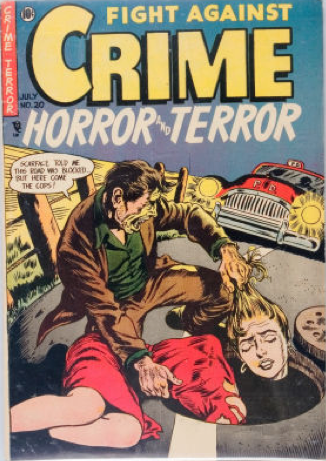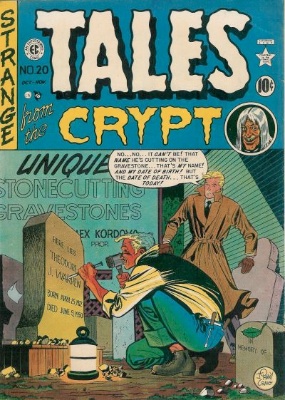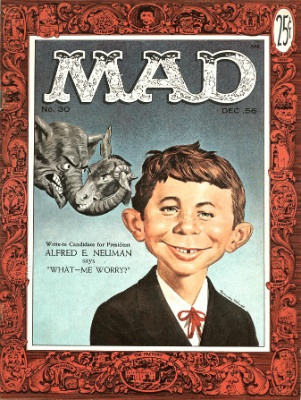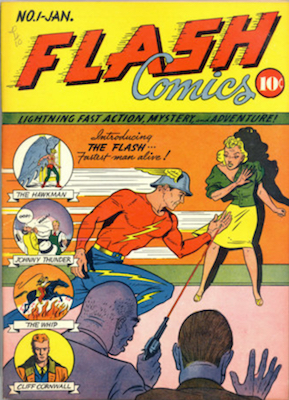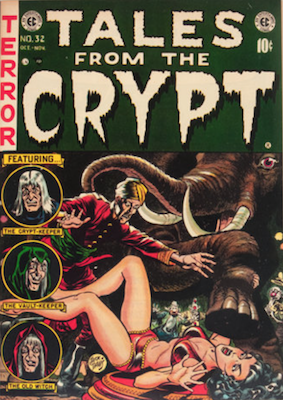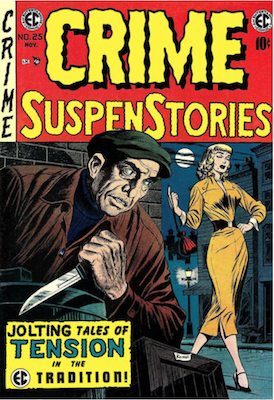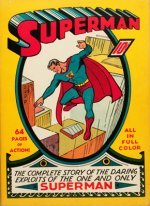Weird Fantasy and Weird Science Comic Book Price Guide
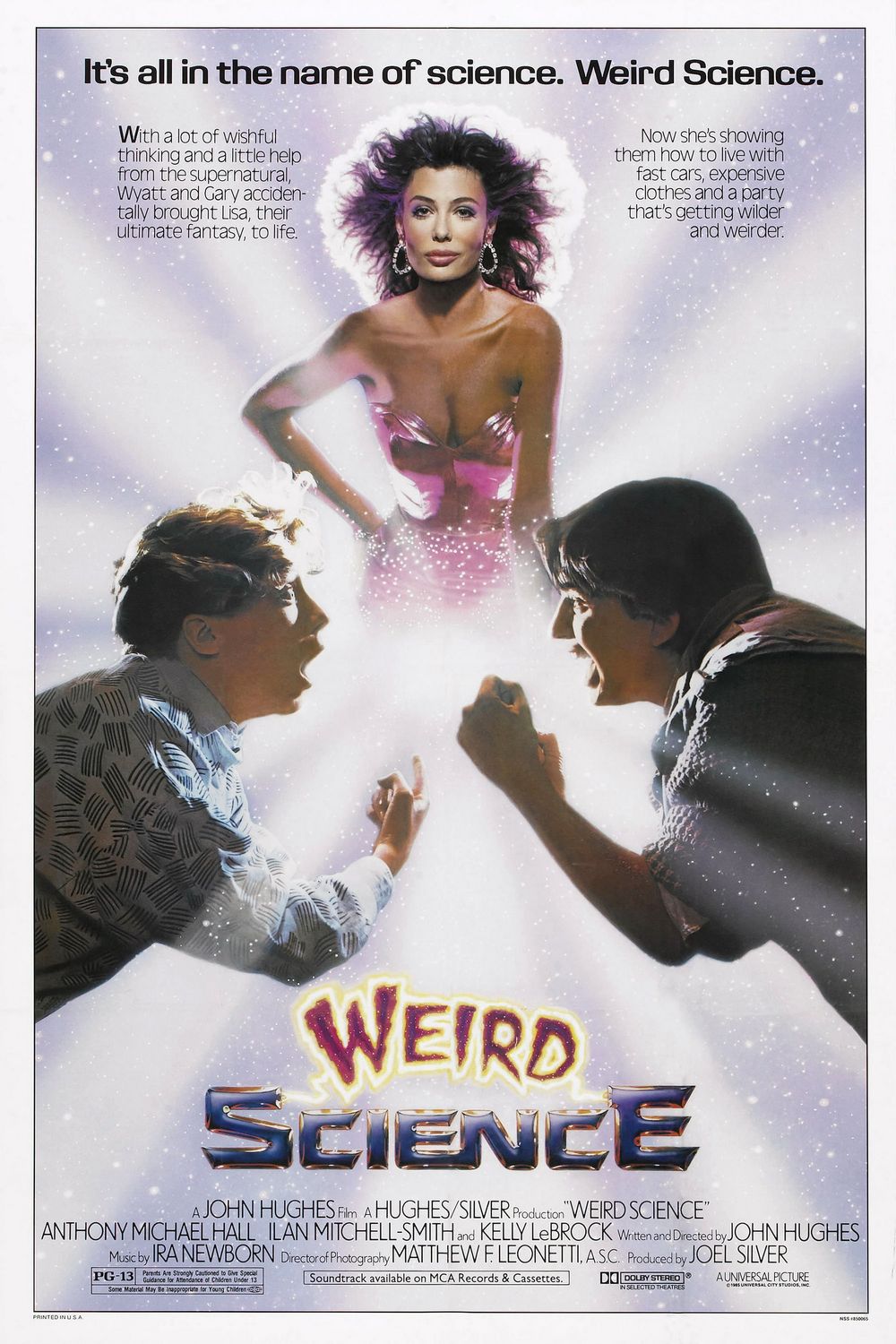
Value of Weird Fantasy and Weird Science Comics
It is probably prudent to get this out of the way right at the beginning.
Yes, the 1985 comic book movie of the same name, which stars Anthony Michael Hall, is, indeed, based on a story from the Golden Age EC Comic, Weird Science #5, from January of 1951.
By now, the image of teenage boys with white lab coats and brassieres on their heads, somehow turning a Barbie doll into Kelly Le Brock, while Oingo Boingo sings the title song, is firmly lodged in your head.
But we're not here to talk about that movie. Instead, we're here to talk about the EC Comic that inspired it, and which has flown under the radar as far as the mainstream of popular culture is concerned.
Weird Science and Weird Fantasy were EC Comics publications that each ran for 22 issues in the early 1950s.
While both of these titles may have escaped the sort of cultural significance that is attached to Tales From the Crypt, for example, they are very much worth investigating, in terms of their historical importance and their value.
The Weird comics, Science and Fantasy (and their successors, Weird Science-Fantasy and Incredible Science Fiction), like any of the Golden Age EC titles, are sought-after by collectors.
Weird Science #12 (May/June 1950): Science Gets Weird
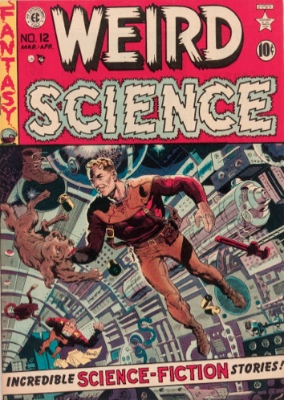
The inaugural issue, Weird Science #12, is classic sci-fi, with Gaines and Feldstein's writing illustrated by Feldstein, Harvey Kurtzman, Wally Wood, and Jack Kamen, inside an iconic Feldstein cover that might just represent what most people like about 1950s science fiction so much.
The stories are very much typical of the EC style during this period, with wry, ironic twists, cynical humor, hostile aliens, shocks, and weirdness aplenty. The cover proclaims them as Scientific SuspenStories We dare you to read!
Some dared, but not enough. In spite of the quality therein, WS #12 just didn't sell very many copies, and as a result is quite valuable to collectors, although perhaps not in direct proportion to its scarcity.
There are not many copies around, and while its value is never going to rival Action Comics #1, in top condition this comic can fetch big bucks.
Record sale: $8,800
Minimum value (poor but complete): $50
Weird Fantasy #13 (May/June 1950): Fantasy Gets Even Weirder
The first issue, Weird Fantasy #13, sits nicely right alongside its Science sister publication.
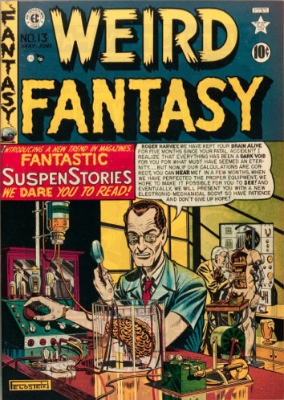
Featuring art from Feldstein, Kurtzman, Kamen, and Wally Wood/Harry Harrison, inside a Feldstein cover, this is prime sci-fi, 1950s-style.
The stories deal with time travel, aliens, telepathy, and a cover story about a brain kept alive after a man's death and eventually installed in a robot body, all imbued with the cynical/weird/humorous/ironic/shocking EC house style.
The cover almost duplicates WS #12's claims, but changes Scientific SuspenStories to Fantastic SuspenStories. Functionally, there really is no difference.
As with WS #12, WF #13 is scarce, with few copies appearing in any condition, and very few in good condition. Even in restored state, this will fetch a healthy sum. In the best condition, it is worth thousands.
Record sale: $8,300
Minimum value (poor but complete): $10
Weird Science #5 (January/February 1951): A Franchise is Born
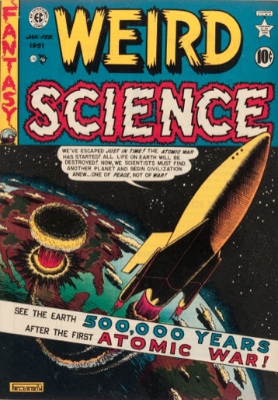
Weird Science #5 is the issue with the story, Made of the Future, that would inspire the very popular teen Weird Science movie more than 30 years later.
In fact, a remake of that 1985 movie is in the works at the moment of writing, courtesy of Joel Silver, also producer of the earlier film.
The story concerns a man who's been rejected by his girlfriend. He meets some time travelers who are visiting 1950 from the far future, a future in which you can buy a kit that will build you an ideal mate.
He returns to 1950 with the kit, and uses it to build himself a girlfriend. He is thrilled with the results, until she leaves him, headed to the future where she feels she belongs. The man can no longer contact his friends from the future, and so he is jilted again.
Made of the Future, while not the cover story of WS #5, is what adds value to this issue, along with the fact that it is an early example of WS from EC's glory period of the late Golden Age.
It is relatively scarce, and highly valued by collectors, although perhaps not as highly as earlier issues of WS and WF.
Record sale: $1,900
Minimum value (poor but complete): $5
Weird Science #22: Last Issue
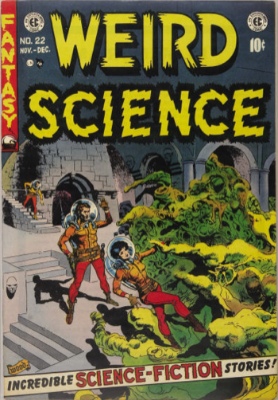
It was poor sales, and not the Code, that brought down EC's sci-fi titles.
The final issue, Weird Science #22, is just as good as the first. In spite of the sales, Gaines and Feldstein had never let the quality slip.
With a fantastic Wally Wood cover that just starts approaching the more Bug-Eyed-Monster end of sci-fi, as seen in the pulps, this issue is filled with the usual stellar writing of Gaines and Feldstein, and the art of Wally Wood, Joe Orlando, Al Williamson, and George Evans.
WS #22 is not worth what #12 is, for example, but in good condition will still fetch a typically fair price for a late-Golden Age EC title.
There aren't that many around, as with any EC sci-fi title.
Record sale: $1,500
Minimum value (poor but complete): $15
Weird Fantasy #22: Last Issue
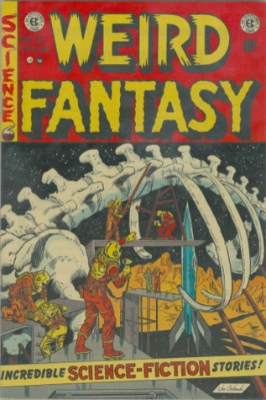
Weird Fantasy #22, the last issue, was simultaneous to WS's, owing to the imminent merger.
Over the years, WF had maintained its high quality just as WS had, and this issue is no exception. WF #22 has cover art by Joe Orlando, and stories illustrated by Orlando, Jack Kamen, Lee Crandall, and Bernie Krigstein.
WF #22, like other examples of WF and WS from later in the run, is scarce and valuable, but not as valuable as the early issues.
Record sale: $1,300
Minimum value (poor but complete): $25
Why This Guide is AWESOME for Wannabe Comic InvestorsIf you have either tried (and failed) to make money flipping comic books, or are frustrated by the huge array of choice out there, then this is the eBook for you. It's packed with 32 in-depth analyses of easy-to-buy and sell comic books from the Bronze to Modern ages. These are titles we have personally made a lot of money buying and selling. So can you. Make more than your money back with your first successful trade (or by NOT buying a losing book!). If you are not completely satisfied, we have a 365-day money-back guarantee. Click to read more, or order your copy today! |
(Article continues below)
Detailed Comic Book Price Guides for EC Series
Click any link to see full details of issue-by-issue prices for the series!
Weird Science-Fantasy #23 (March 1953): Combined Weirdness
Weird Science-Fantasy is the result of WS and WF merging.
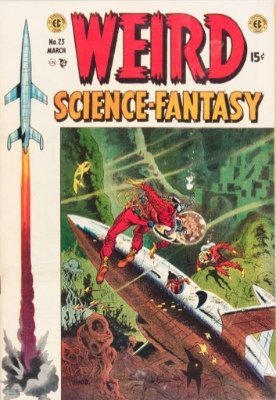
Bill Gaines had carried both titles as long as he could, but even his love for these titles and for science fiction in general could not justify continuing to run two comics in the red.
Gaines also decided to scale production back from bimonthly to quarterly, producing longer issues. This also compelled him to raise the price to 15c, which didn't do much to help sales.
WS-F #23 continues the fine work begun in WS and WF, with a beautiful cover by Wally Wood, and art inside by Wood, Joe Orlando, Al Williamson, Bernie Krigstein, and Roy Krenkel.
Although somewhat less scarce than its predecessors, WS-F #23 is still sought-after by collectors, in part because the story The Flying Machine is an excellent example of the many Ray Bradbury adaptations after Bradbury's agreement with EC started.
Record sale: $1,060
Minimum value (poor but complete): $15
Incredible Science Fiction #30 (July/August 1955): Incredible Weirdness
After only seven issues, Gaines was compelled by the Code to retitle WS-F to eliminate the word "Weird".
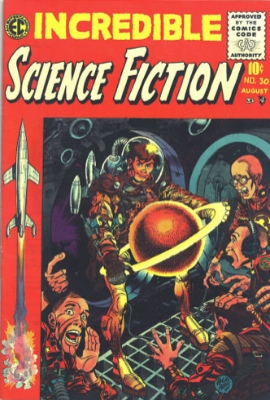
Don't ask. No one can know why the Code decided that the word "weird" would curve the spines of young America.
That word's commonly-accepted current meaning of "strange or unusual, out of the ordinary," doesn't seem so bad. The Old English meaning of the word, "wyrd," meant "the future, or fate."
The original meaning became the modern meaning sometime after William Shakespeare's Macbeth became popular. In the play, Macbeth encounters the "weird sisters," who tell him his future. 19th Century American audiences assumed that the word meant "strange", because the sisters in question were so odd and witchy and such.
In any case, the new title of Incredible Science Fiction #30 did not affect the content. As usual, ISF had stellar cover art, this time by EC Mainstay Jack Davis, better known for his work in the horror comics and in MAD Comics.
The interior illustrations are by Davis, Wood, Orlando, and Krigstein, and are also of the same high quality that characterized all of EC's glory period.
ISF #30 is scarce in higher grade.
Record sale: $995
Minimum value (poor but complete): $15
Incredible Science Fiction #33 (Jan/Feb 1956): The End of EC Comics
The final comic book ever produced by EC comes with a story that reveals the ridiculous persecution of Bill Gaines under the Comics Code Authority, and the institutionalized racism that the Code and its makers attempted to further.
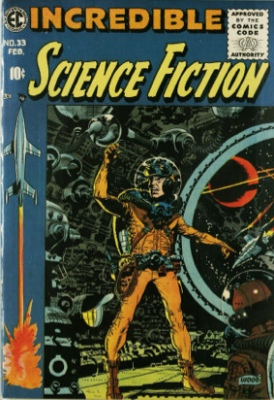
Gaines, now submitting issues in advance to the Code Authority, had a story intended for Incredible Science Fiction #33 returned as failing to meet Code standards.
According to Gaines, while other reasons were given, he believed that it was because the story's main character was black.
Pressed for time and wanting, more than likely, to push some buttons at the Code Authority, Gaines decided to reprint a story called Judgment Day, illustrated by Joe Orlando, which had originally appeared in the pre-Code Weird Fantasy #18.
In the story, an astronaut representing the Galactic Republic visits the planet Cybrinia, which is inhabited solely by robots. The robots are divided into orange and blue races, but are otherwise, functionally identical.
One of the races, however, has fewer rights and privileges than the other, based simply on the color. The astronaut decides the robots' prejudice should preclude the Galactic Republic from admitting the planet to its ranks.
In the last panel of the story, the astronaut takes off his helmet for the first time in the story, revealing himself to be a black man.
According to Gaines, Judge Charles Murphy, administrator of the Comics Code, told him that the black astronaut had to go. Citing no reason as written in the code, Murphy insisted, despite Gaines and Feldstein's assertions that it was a racist decision and that the Code simply wanted any excuse to put EC out of business.
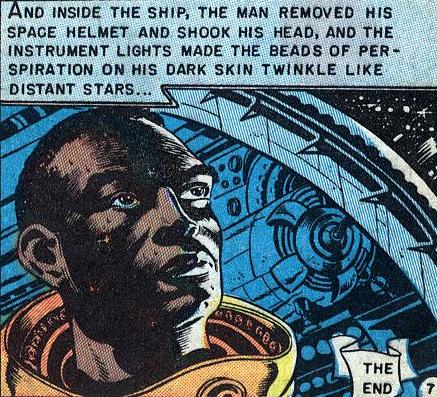
The final panel of the story, Judgement Day, reprinted in Incredible Science Fiction #33 from the original story in Weird Fantasy #18, revealed racial tensions in the Comics Code Authority
Murphy finally relented after heated debate, telling Gaines that the black astronaut could stay, but that he must remove the beads of sweat on the astronaut's face.
Gaines' two-word reply, uttered with some vehemence just before hanging up on Murphy, contained a monosyllabic Anglo-Saxon expletive of great vigor and popularity.
EC ran the story without removing the sweat, and the comic ran with Code approval. It was, however, the straw that broke the camel's back. EC was no more.
Gaines had switched MAD to magazine format, because the Code's reach did not extend to magazines, but only to comics.
ISF #33 was the last issue of any comic book to bear the EC insignia until the various reprints and revivals later on. Of those, there is little to say except that reprints fail to tell the whole story, fail to convey its cultural significance.
As the last EC comic book ever printed, Incredible Science Fiction #33 is quite significant, historically. It has a dazzling Wally Wood cover, truly outstanding, even compared to Wood's usually high-quality work.
The art inside, by Wood, Bernie Krigstein, Jack Davis, and Angelo Torres, is dazzling as always. The stories, all from Feldstein and Gaines, are of the usual high quality as well.
ISF, and EC, went out in style. ISF #33 is of tremendous historical importance, and is relatively scarce.
Record sale: $2,990
Minimum value (poor but complete): $5
More History of EC Weird Comics
Weird Style
As you might imagine, with titles like Weird Science and Weird Fantasy, the general trend here is towards science fiction, but not the kind of "space opera" sci-fi that you might have found in the pulps, or in comics like Planet Comics, for example.
Instead, the stories cover a spectrum that ranges from so-called "hard science fiction" to "science fantasy" to "speculative fiction," and other styles, somewhat harder to classify.
These are not EC horror comics, but have as much merit as their horrific brethren, if not as much recognition. They came from the same fertile minds (Bill Gaines and Al Feldstein, along with Gardner Fox and a few others) as the EC horror titles, and shared most of the illustrators seen in those titles as well.
Gorgeous covers and interior art by the legendary likes of Wally Wood, Frank Frazetta, and Harvey Kurtzman, among many others, are the true legacy of WS and WF.
In fact, it should be noted that EC's science-fiction titles were the ones that Bill Gaines has said more than once that he was most proud of. In fact, WS and WF were both poor-selling titles, and Gaines has said that he kept them both running in the red for more than a year, buoyed by the profits from the horror comics.
In that sense, we can look at WS and WF this way: Gaines used the horror comics as his "day job" to finance the sci-fi comics (his true passion).
It should be noted that these legendary, beautifully-illustrated, historically-important comics are full of examples of Gaines and Feldstein taking ideas from then-contemporary sci-fi short stories Gaines was reading, and using them as what Gaines called "springboards" to create the scripts for WS and WF.
Most of the writers involved seem to have either failed to notice or did not think the matter worth pursuing, with the exception of Ray Bradbury. Sci-fi legend Bradbury had certainly noticed the "inspiration" that Gaines took from several of his stories in Haunt of Fear and in Weird Fantasy.
Bradbury contacted Gaines, but he did not threaten to sue him. Bradbury took a less-litigious route that Gaines must have appreciated tremendously. His letter to Gaines is the stuff of legend, and in part it reads, "Just a note to remind you of an oversight. You have not as yet sent on the check for $50.00 to cover the use of secondary rights on my two stories THE ROCKET MAN and KALEIDOSCOPE... I feel this was probably overlooked in the general confusion of office work, and look forward to your payment in the near future."
Gaines, of course, took the "out" that Bradbury was offering him, sending a check post-haste. The two became friends, and Bradbury worked out a deal with Gaines for exclusive rights to comic adaptations of his work, which continued until Gaines shut down all of EC's comics in 1955.
Unraveling Tangled Titles
Like most Golden Age EC titles, These have a tangled history, especially in terms of numbering. Keeping it straight is difficult, but when looked at chronologically, it seems clearest.
In 1947, EC, then known as "Educational Comics," started a title called The Happy Houlihans. It is just what the title suggests. It ran for two issues, and then the title was switched to Saddle Justice, and the format to Western crime, with #3.
With #8, there was another change, to the self-explanatory Saddle Romances, which lasted through #11. With #12, Gaines finally made the switch to Weird Science.
Meanwhile, in 1950, EC's Moon Girl and The Prince began, and lasted one issue before becoming, simply, Moon Girl, and then, six issues later, Moon Girl Fights Crime.
After two issues, the title became A Moon, a Girl... Romance, which lasted four issues, before becoming Weird Fantasy with #13.
All these changes of titles without changing the numbering were purposeful moves by Gaines, looking to save money on second-class postage. Of course, the USPS noticed this, and it caught up to Gaines by late 1950. Gaines opted to re-number subsequent issues of both Weird Science and Weird Fantasy.
Weird Science then "re-launched" with the new #5, since #12, #13, #14, and #15 were now considered to have been issues 1-4 of the new title. This means that the numbering began anew in January 1951 with #5 and ran sequentially through #22 in 1953.
Therefore, while there are no actual #1, #2, #3, or #4 of WS, there are TWO ISSUES EACH of #12, #13, #14, and #15!
To save confusion, we will use the dates to distinguish between the different issues with the same #s (e.g., WS#12 1950, or WS#13 1952, etc.).
Adding to the confusion, many collectors refer to the first #12-#15 as #1-#4, making them conform to the re-launch numbering.
Weird Fantasy's situation is similar, with issues #13-#17 supplanted by a re-launch with #6 in March of 1951. So, there are TWO ISSUES EACH of WF with #13-#17 on them.
Just as confusingly as with WS, the earlier issues with those issue numbers are often referred to as #1-#5 by collectors.
In 1953, prompted by the poor sales of the two sci-fi titles, Gaines merged them, into Weird Science-Fantasy.
Since both titles had by then reached #22 in their runs, the numbering for WS-F starts with #23. With #29, the title was changed again.
Reeling from the relentless hounding he'd suffered under the Comics Code Authority, Gaines was at great pains to remove the word "Weird" from his titles, since it had been banned by the Code.
So, with #30, Incredible Science Fiction was born, which lasted four issues, before Gaines decided to pack in his comics division entirely and concentrate on MAD Magazine.
All Our Horror Comics Price Guides
- 60 Most Valuable Horror Comic Books
- Gallery of the Gross Horror Comics!
- Adventures into Terror
- Adventures into the Unknown
- Astonishing!
- Black Cat and Black Cat Mystery Comics
- Blade the Vampire Slayer
- Chamber of Chills (Harvey)
- Crime Does Not Pay
- Crime SuspenStories
- Crypt of Terror
- Frankenstein Comics
- Ghost Rider
- Haunt of Fear
- House of Mystery
- House of Secrets
- Journey into Mystery
- Marvel Horror Comics
- Marvel Spotlight
- Marvel Tales
- Mister Mystery Comics
More of our Comic Price Guides
Grossest and Best Horror Comics
Find out the value of the most gory and gruesome pre-Code horror comic books!
Weird Science and Other EC Comics Price Guides
Learn the value of EC Comics, including MAD, Tales From the Crypt, Vault of Horror, and many more.
MAD Magazine Comic Book Price Guide
First it was MAD Comic, then MAD Magazine! Learn the value of key issues.
Most Valuable Comic Books of All Time
From Wonder Woman to the Flash first appearances, find out which comics are killer in the market.
Crypt of Terror 17-19 and Tales from the Crypt 20 and Up
More EC Comics which are sought after in this classic horror series.
Crime SuspenStories Comic Values
EC Comics were infamous for hanging, decapitation and other gory goodness! Find out values here.



